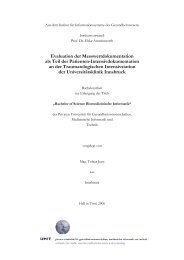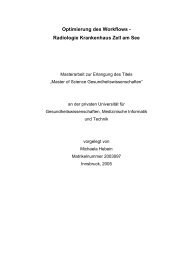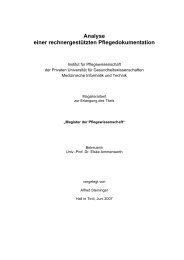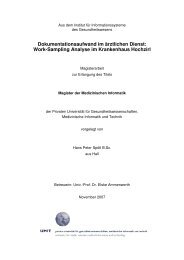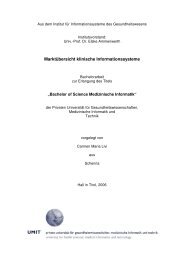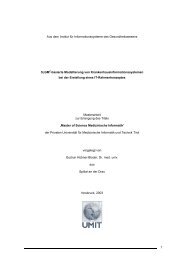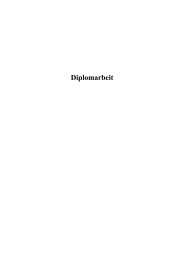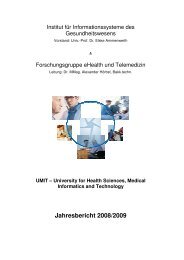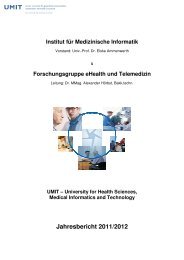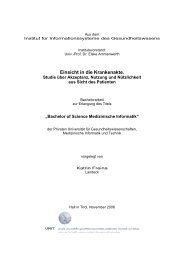XML-‐basierte Kommunikation im IHE - Institute of Health ...
XML-‐basierte Kommunikation im IHE - Institute of Health ...
XML-‐basierte Kommunikation im IHE - Institute of Health ...
Erfolgreiche ePaper selbst erstellen
Machen Sie aus Ihren PDF Publikationen ein blätterbares Flipbook mit unserer einzigartigen Google optimierten e-Paper Software.
Abstract<br />
Increasing specialisation in healthcare pr<strong>of</strong>ession and the related division <strong>of</strong> work in treat-‐<br />
ing patients lead to a restricted access in patient documents. Usually only the institution<br />
that has adjudged a document is able to admit it. However an integrated patient-‐centered<br />
care requires a close communication between all involved healthcare pr<strong>of</strong>essions in treat-‐<br />
ing a patient. The electronic health record (EHR, in Austria: ELGA) solves this problem by a<br />
cross-‐organisational distribution <strong>of</strong> healthcare documents. But this connection also causes<br />
unmanageable document overflow, which leads to a considerable problem in treatment<br />
because a lot <strong>of</strong> t<strong>im</strong>e is needed to look into all documents.<br />
The project EHR-‐Arche <strong>of</strong> the University for <strong>Health</strong> Sciences, Medical Informatics and<br />
Technology (UMIT) and the Medical University <strong>of</strong> Vienna tries to solve this problem with a<br />
web-‐based search-‐tool that delivers all relevant documents out <strong>of</strong> an EHR in order to an-‐<br />
swer a restrictive question <strong>of</strong> a physician. The project is based on the <strong>IHE</strong>-‐XDS pr<strong>of</strong>ile,<br />
which gets enhanced by two new actors that make it possible to find information in docu-‐<br />
ments in regard to the content. The concept for a content-‐related search requires full<br />
structured documents, which are given by the dual-‐model approach with reference model<br />
and archetypes.<br />
The Document Consumer (standard XDS actor) gets connected with flexible interfaces to<br />
the new actors. So called infoitems describe medical concepts in archetypes e.g. systolic<br />
blood pressure. They are used to form an arbitrary query in the document consumer. The<br />
new document crawler actor processes this query and returns the results (e.g. a certain<br />
blood result) to the consumer with a link to the relevant document. The new archetype<br />
repository actor (ATR) contains all archetypes with its infoitems and can <strong>of</strong>fer them in a<br />
structured manner, so the document consumer is able to load these infoitems. In this the-‐<br />
sis the interfaces from the document consumer to the new XDS-‐actors were planned, <strong>im</strong>-‐<br />
plemented and tested. Therefor following sub-‐goals were processed:<br />
Sub-‐goal 1: First a concept for creating a query was made, which is used together with the<br />
interface specifications <strong>of</strong> the enhanced actors, to form the basis for the <strong>im</strong>plementation.<br />
Thereby the concept specifies that proprietary <strong>XML</strong>-‐messages are used for communication<br />
between the actors, while JAVA-‐Objects are used in the document consumer internal.<br />
Sub-‐goal 2: The concept-‐based <strong>im</strong>plementation allows to load all infoitems, which are pro-‐<br />
vided in structured <strong>XML</strong>-‐format from the ATR. It parses this <strong>XML</strong>-‐message and saves it in a<br />
tree-‐based JAVA-‐structure. The nodes <strong>of</strong> this structure (infoitems) can be free combined,<br />
constrained (e.g. only a certain blood result) and structured in the searchquery-‐class. This





